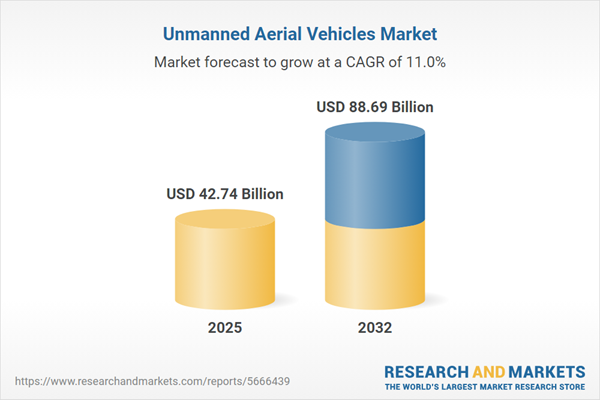Speak directly to the analyst to clarify any post sales queries you may have.
The unmanned aerial vehicles market is evolving rapidly, driven by widespread adoption across commercial and defense sectors. Enhanced technology, regulatory momentum, and dynamic regional developments are expanding opportunities and redefining operational possibilities for industry stakeholders seeking to maximize value from UAV integration.
Unmanned Aerial Vehicles Market Snapshot
The global unmanned aerial vehicles market moved from USD 38.46 billion in 2024 to USD 42.74 billion in 2025. Expected to grow at a CAGR of 11%, the sector is forecast to reach USD 88.69 billion by 2032. Senior leaders can expect the market to continue expanding as UAV solutions become critical to digital transformation strategies and operational efficiency initiatives across diverse industries.
Scope & Segmentation
This report offers an in-depth analysis of market dimensions, focusing on platforms, technology adaptation, regional activity, and key applications shaping industry dynamics.
- Platform Types: Fixed wing (electric, piston engine), hybrid (tiltrotor, VTOL), and rotary wing (multi-rotor, single rotor) drones enable customized solutions for surveillance, inspection, and precision operations.
- Range Capabilities: Close range, short range, mid range, and long range vehicles address both indoor and cross-border missions, aligning UAVs to a spectrum of operational requirements.
- Propulsion Technologies: Electric, gasoline, and hybrid solutions allow operators to balance emissions, payload, and flight duration, supporting evolving end-user objectives.
- Application Focus: Use cases span aerial photography, agricultural spraying and monitoring, delivery and logistics, inspection, mapping, surveying, and security, underscoring versatile UAV appeal.
- End Users: Commercial and defense stakeholders are deploying UAVs to improve data acquisition, streamline logistics, and strengthen mission reliability.
- Regional Coverage: The Americas; Europe, Middle East & Africa; and Asia-Pacific regions, including major markets such as the United States, China, Germany, India, Japan, and Brazil, illustrate unique adoption drivers and regulatory climates.
- Company Coverage: Key players include SZ DJI Technology Co., Ltd., Parrot SA, Yuneec International Co., Ltd., Shenzhen Autel Intelligent Technology Co., Ltd., AeroVironment, Inc., General Atomics Aeronautical Systems, Inc., Northrop Grumman Corporation, The Boeing Company, Textron Inc., and Israel Aerospace Industries Ltd.
Key Takeaways
- Autonomous navigation, advanced sensing, and real-time data transmission are enabling UAV adoption in critical workflows far beyond imaging solutions.
- Regulatory frameworks worldwide are adapting, paving the way for safer, larger-scale deployments and supporting new business models in commercial and defense domains.
- OEMs and suppliers are optimizing designs for modularity, allowing rapid sensor and payload changes tailored to industry-specific missions.
- Hybrid and electric powertrains are improving flight endurance and operational flexibility, strengthening the case for UAVs across diverse environments.
- Collaborative swarming, data sharing, and interoperability standards are accelerating the shift from standalone UAVs to integrated, networked aerial systems.
Tariff Impact: Navigating Supply Chain Disruptions
Recent United States tariff announcements in 2025 introduced higher duties on components such as optics and semiconductors, challenging the UAV market’s global supply chain. Manufacturers face increased costs, longer lead times, and complex customs processes. Commercial and defense stakeholders are responding by pursuing alternative sourcing strategies, investing in domestic facilities, and intensifying supplier partnerships to mitigate trade-related risks. Companies are also refining procurement and design practices to maintain price competitiveness in end-user markets.
Methodology & Data Sources
The research employs primary interviews with executives, system integrators, and policy experts, supported by analysis of technical literature, patents, and regulatory documentation. Proprietary supplier databases are cross-verified with logistical data to ensure accurate tracking of components and supply chain resilience. Scenario-based modeling is integrated to assess potential market impacts from tariffs, regulatory shifts, and operational disruptions.
Why This Report Matters
- Strategic insights support senior leaders in navigating technology, regulatory, and supply chain complexities unique to the UAV domain.
- Segmented market coverage gives decision-makers actionable data to refine product development, investment, and go-to-market strategies.
- Forward-looking analysis empowers organizations to identify growth regions, adapt to evolving user requirements, and benchmark against industry innovators.
Conclusion
This report equips stakeholders with an integrated perspective on evolving technologies, market segmentation, and supply chain challenges in the unmanned aerial vehicles market. Informed strategies are critical to capturing growth and enabling future-ready operations as UAV deployment expands globally.
Additional Product Information:
- Purchase of this report includes 1 year online access with quarterly updates.
- This report can be updated on request. Please contact our Customer Experience team using the Ask a Question widget on our website.
Table of Contents
3. Executive Summary
4. Market Overview
7. Cumulative Impact of Artificial Intelligence 2025
Companies Mentioned
The companies profiled in this Unmanned Aerial Vehicles market report include:- SZ DJI Technology Co., Ltd.
- Parrot SA
- Yuneec International Co., Ltd.
- Shenzhen Autel Intelligent Technology Co., Ltd.
- AeroVironment, Inc.
- General Atomics Aeronautical Systems, Inc.
- Northrop Grumman Corporation
- The Boeing Company
- Textron Inc.
- Israel Aerospace Industries Ltd.
Table Information
| Report Attribute | Details |
|---|---|
| No. of Pages | 195 |
| Published | October 2025 |
| Forecast Period | 2025 - 2032 |
| Estimated Market Value ( USD | $ 42.74 Billion |
| Forecasted Market Value ( USD | $ 88.69 Billion |
| Compound Annual Growth Rate | 11.0% |
| Regions Covered | Global |
| No. of Companies Mentioned | 11 |









